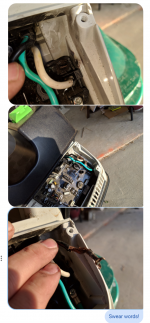I wasn't paying attention and one of my guys plugged a new Sawstop Jobsite tool into the dust extractor. Eventually, neither would come on. The Sawstop was fine. The vac was not. I took it apart and the board was fried. Hope a new board replacement fixes it. :'(
You are using an out of date browser. It may not display this or other websites correctly.
You should upgrade or use an alternative browser.
You should upgrade or use an alternative browser.
CT26 on the jobsite
- Thread starter NoDeuces
- Start date
Jiggy Joiner
Member
- Joined
- Dec 25, 2018
- Messages
- 1,103
He’s not employee of the month then? [tongue]
What rating was the tool he plugged into it, out of interest?
What rating was the tool he plugged into it, out of interest?
AlexThePalex
Member
- Joined
- Nov 12, 2008
- Messages
- 7,808
That sucks. But how can you even draw so much amp your board gets fried but the mains fuse does not trip?
Jiggy Joiner
Member
- Joined
- Dec 25, 2018
- Messages
- 1,103
Alanbach said:Sawstop’s jobsite saw is 1.5Hp and is rated at 15 amps according to the specs on their website.
That’s a bummer but, I’m thinking the same as Alex, I wonder why it didn’t pop a fuse?
kevinculle
Member
Circuit breakers are engineered to deal with the brief peak starting currents for devices whose running current falls within the specified amperage. A typical breaker on a 120V circuit will tolerate a brief starting current of 250% of it's rated current, so a 15A breaker will carry 37.5A during the milliseconds before the rotor starts turning. A 1-1/2HP motor that draws 12-14A at "full load" would be expected to draw 25-30A during startup. It should not be surprising that this popped the CT while the branch circuit breaker remained engaged.
cpw
Member
You would think that a well engineered vacuum would have an internal breaker, fuse, or thermal overload so that it avoids melting itself.kevinculle said:Circuit breakers are engineered to deal with the brief peak starting currents for devices whose running current falls within the specified amperage. A typical breaker on a 120V circuit will tolerate a brief starting current of 250% of it's rated current, so a 15A breaker will carry 37.5A during the milliseconds before the rotor starts turning. A 1-1/2HP motor that draws 12-14A at "full load" would be expected to draw 25-30A during startup. It should not be surprising that this popped the CT while the branch circuit breaker remained engaged.
Farming_Sawyer
Member
- Joined
- Sep 13, 2018
- Messages
- 124
Was either of the tools fed by an extension cord? How many miles of wiring were between the CT and the panel?
sancho57
Member
- Joined
- Jan 13, 2011
- Messages
- 7,089
Hmmmm I plugged my 5" jet jointer into my CT 26 many times with no problems. I guess it must of been under pretty heavy load for a CT to be fried. I also have used a shop vac as a DC in the past on my delta table saw 1.5 hp with no issues. (dont own the TS anymore).
hAve you alked to festool and found out the load capabilites for the 26?
hAve you alked to festool and found out the load capabilites for the 26?
kevinculle
Member
I agree an overload protection feature in the CT26 would be beneficial. Festool is very schizophrenic on the amperage capability of the CT26. The label on the vac next to the outlet says "to reduce the risk of fire connect tools of amperage draw less than 3.7A..." but at the same time they say it is useable with any Festool tool including the Kapex, which has a stated power consumption of 1600 watts or a bit over 13A. Of course if you install the Bluetooth module that label is no longer on the vac. Perhaps the biggest factor is that the Kapex has a soft start feature that likely limits starting current draw much more than a straight induction motor.
I wonder how the CT could be fried, as the only thing that it's doing is to measure energy flow through the socket to decide if it should activate or not - a function that can be done completely electrical contact free and is that cheap that it retails for less than $20 when not even searching for a cheap one: eg.https://www.amazon.com/bayite-Digital-Current-Voltage-Transformer/dp/B01DDQM6Z4/
A detection function build on that principle would have a BOM of certainly less than 1$ when buying the parts in bulk.
The only part of the CT that could fry should be the switch, anything other (like the board)... indicates design failure. IMHO.
A detection function build on that principle would have a BOM of certainly less than 1$ when buying the parts in bulk.
The only part of the CT that could fry should be the switch, anything other (like the board)... indicates design failure. IMHO.
Similar threads
- Replies
- 8
- Views
- 701
- Replies
- 40
- Views
- 2K
- Replies
- 15
- Views
- 14K

